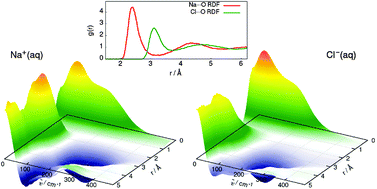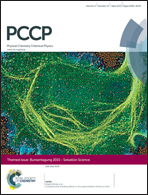Solvation shell resolved THz spectra of simple aqua ions – distinct distance- and frequency-dependent contributions of solvation shells†
Abstract
Hydration of ions is a topic of broad relevance in chemistry and biology. Liquid-state terahertz spectroscopy has been demonstrated to be able to detect even small solute-induced changes in the hydrogen bond network dynamics at the solute–water interface. Here, we apply ab initio molecular dynamics simulations to study the solvation of Na+ and Cl− in bulk water in the context of their far-infrared responses. Spatial decomposition schemes for infrared spectra down to the THz regime reveal the importance of both dipolar couplings and correlations in particle motion in these aqueous solutions. The explicit representation of the electronic structure properly captures the solute–solvent polarization effects that are crucial for the interpretation of recent experimental data. This demonstrates that theoretical spectroscopy significantly complements experimental measurements and provides most detailed insights by selectively monitoring the spectral activity due to distinct hydration spheres.

- This article is part of the themed collection: Bunsentagung 2015: Solvation Science

 Please wait while we load your content...
Please wait while we load your content...